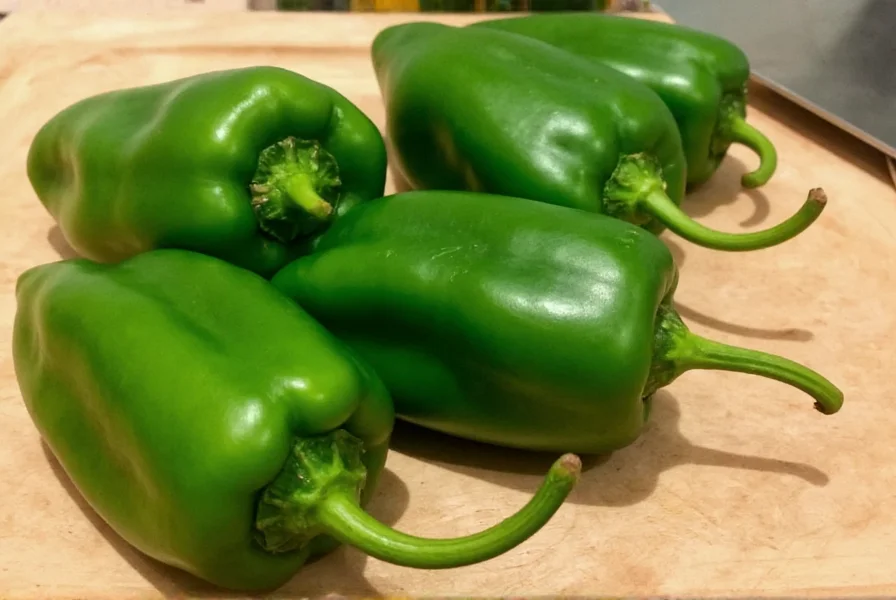When exploring how spicy are poblano peppers, it's essential to understand their position on the chili pepper spectrum. These large, dark green peppers native to Mexico deliver a subtle heat that enhances dishes without overwhelming them. Unlike their fiery cousins, poblanos provide culinary versatility that makes them a staple in authentic Mexican cuisine and fusion cooking worldwide.
Understanding Poblano Pepper Heat Levels
Poblano peppers fall at the lower end of the spiciness scale, making them accessible to those with moderate heat tolerance. The Scoville scale measures capsaicin concentration—the compound responsible for heat in chili peppers. At 1,000-2,000 SHU, poblanos register as mild, comparable to banana peppers but noticeably less intense than serranos or habaneros.
Several factors influence poblano pepper heat level compared to jalapeno varieties:
- Ripeness: As poblanos mature and turn from dark green to reddish-brown (when dried, they become ancho peppers), their heat slightly increases while developing sweeter, fruitier notes
- Growing conditions: Soil quality, climate, and water stress can cause natural variations in capsaicin production
- Individual pepper variation: Even within the same plant, heat levels can differ between peppers
| Pepper Variety | Scoville Heat Units (SHU) | Heat Level Description |
|---|---|---|
| Poblano | 1,000-2,000 | Mild, earthy with gentle warmth |
| Jalapeño | 2,500-8,000 | Moderate heat with grassy flavor |
| Serrano | 10,000-23,000 | Noticeably hot with bright flavor |
| Habanero | 100,000-350,000 | Extremely hot with tropical fruit notes |
Culinary Applications of Poblano Peppers
Chefs value poblanos for their what does a poblano pepper taste like profile—earthy, slightly sweet, and complex with just enough heat to add dimension. Their thick walls make them ideal for stuffing, roasting, and blending into sauces. When roasted, poblanos develop a smoky depth that forms the foundation of classic dishes like chiles rellenos and mole poblano.
For home cooks wondering are poblano peppers hot in recipes, the answer depends on preparation:
- Raw: Mild heat with fresh, grassy notes (common in salsas)
- Roasted: Reduced heat with enhanced smoky, sweet characteristics
- Stuffed: Heat mellowed by cheese or other fillings
- Dried (as anchos): Deeper, fruitier flavor with slightly increased heat

Managing Poblano Pepper Heat
If you're sensitive to spice or preparing dishes for varied palates, consider these techniques for mild chili peppers for cooking success:
Remove the white pith and seeds—the primary concentration of capsaicin resides in these areas. Roasting and peeling poblanos further reduces heat while preserving flavor. For maximum mildness, blanch peppers in boiling water for 2-3 minutes before use.
When substituting in recipes requiring poblano pepper scoville scale rating considerations:
- Milder option: Bell peppers (0 SHU) for color and texture without heat
- Similar heat: Cubanelle or Anaheim peppers (500-2,500 SHU)
- Hotter option: Jalapeños (use half the quantity to match heat)
Practical Usage Tips
Many home cooks wonder can you eat poblano peppers raw. Absolutely! Raw poblanos work well in fresh salsas, salads, and as a crunchy snack. Their mild heat won't overwhelm other ingredients, making them versatile for both cooked and raw applications.
For optimal freshness, store unwashed poblanos in the crisper drawer of your refrigerator for up to two weeks. For longer storage, roast, peel, and freeze them in airtight containers—they'll maintain quality for 6-8 months.

Conclusion
Poblano peppers offer the perfect balance of flavor and mild heat that makes them indispensable in many kitchens. Understanding their poblano pepper heat level compared to jalapeno helps cooks confidently incorporate them into diverse dishes. Whether you're preparing traditional Mexican cuisine or experimenting with fusion recipes, poblanos provide complex flavor without overwhelming spice—making them an excellent choice for expanding your culinary repertoire with approachable heat.
Frequently Asked Questions
How does poblano pepper heat compare to jalapeño?
Poblanos are significantly milder than jalapeños. While poblanos measure 1,000-2,000 Scoville Heat Units (SHU), jalapeños range from 2,500-8,000 SHU. This means even the hottest poblano is milder than the mildest jalapeño. Poblanos provide gentle warmth with earthy flavor, whereas jalapeños deliver more pronounced heat with grassy notes.
Are poblano peppers too hot for children?
Generally, poblano peppers are mild enough for most children when prepared properly. Removing the seeds and white membranes reduces heat significantly. Many family-friendly dishes like stuffed poblanos or mild poblano cream sauces use these peppers without causing discomfort for young eaters. Their heat level is comparable to black pepper rather than intensely spicy chilies.
Do poblano peppers get hotter when cooked?
No, cooking actually reduces the perceived heat of poblano peppers. The capsaicin compounds become more evenly distributed but don't increase in concentration. Roasting, in particular, breaks down some heat compounds while enhancing sweetness. Many people find roasted poblanos noticeably milder than their raw counterparts, making them even more versatile for various dishes.
What's the difference between fresh poblanos and dried anchos?
Dried poblanos are called ancho peppers. While fresh poblanos have a grassy, vegetal flavor with mild heat, anchos develop deeper, sweeter notes with hints of dried fruit, tobacco, and chocolate. The drying process concentrates flavors and slightly increases heat (anchos measure 1,000-2,000 SHU, same range but often perceived as stronger). Anchos are essential in mole sauces and other traditional Mexican dishes requiring complex chili flavor.
Can I substitute bell peppers for poblanos in recipes?
You can substitute bell peppers for poblanos when you want to eliminate heat while maintaining similar texture and appearance. However, you'll lose the distinctive earthy flavor that poblanos provide. For better flavor matching, consider using Anaheim peppers (similar heat level) or adding a pinch of smoked paprika to bell peppers to approximate the poblano's characteristic taste. Bell peppers work well in stuffed pepper recipes where heat isn't desired.











 浙公网安备
33010002000092号
浙公网安备
33010002000092号 浙B2-20120091-4
浙B2-20120091-4